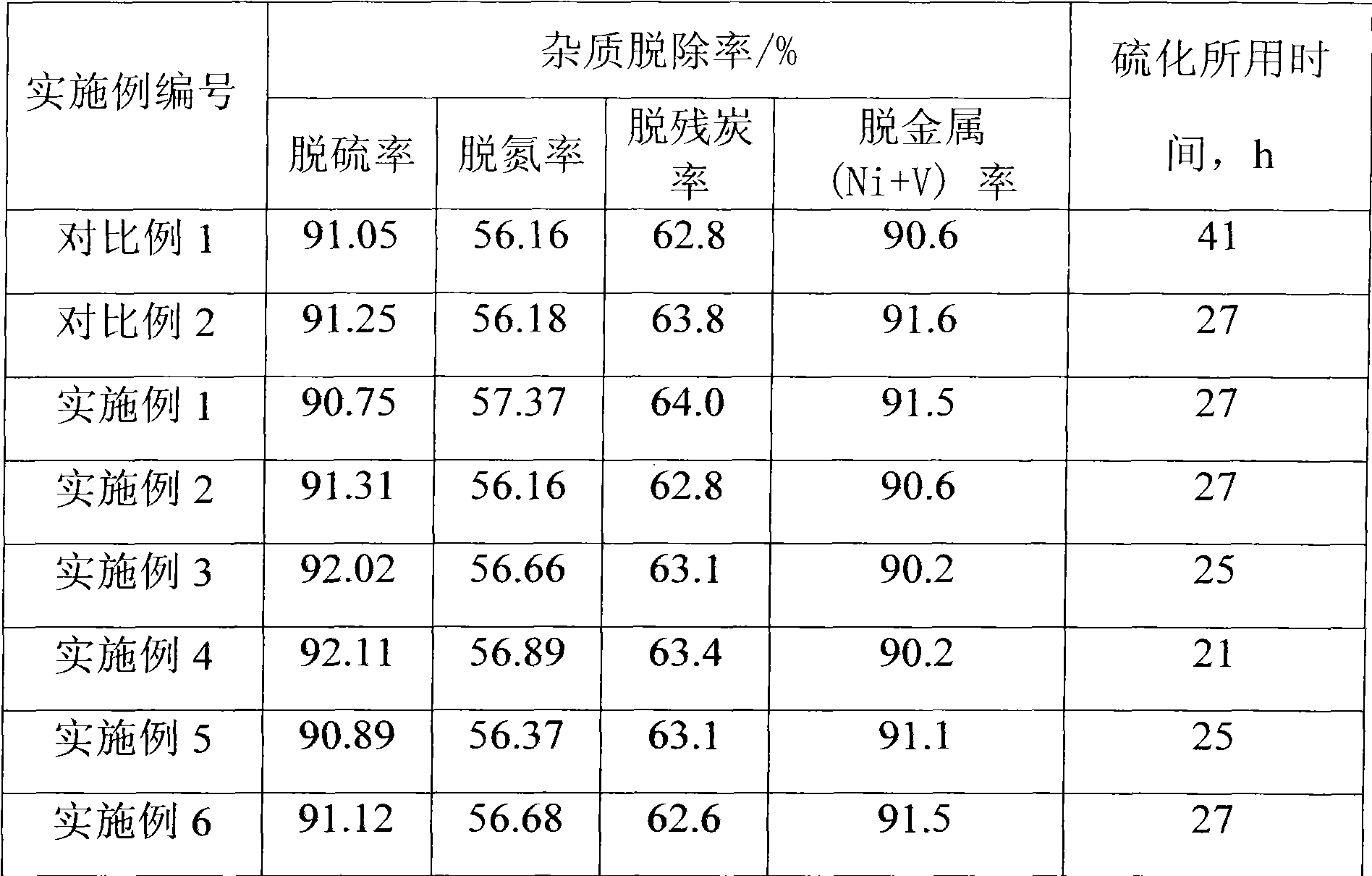On-stream method of residual oil hydrogenation process
A technology for residual oil hydrogenation and process, which is applied in the directions of chemical instruments and methods, catalyst activation/preparation, physical/chemical process catalysts, etc., and can solve problems that affect the on-time start-up of residual oil hydrogenation units, complicated production process, and increased processing costs, etc. problems, to achieve the effect of reducing human body damage, simple equipment, and uniform pre-vulcanization process
- Summary
- Abstract
- Description
- Claims
- Application Information
AI Technical Summary
Problems solved by technology
Method used
Image
Examples
Embodiment 1
[0050] FZC-30 is 100g, soaked in 15g of organic solvent (the organic solvent is coking kerosene fraction), the proportion of carbon number 9-12 in the organic solvent is not less than 50%, and the soaking time is 1 hour. Elemental sulfur 30g and 7.5g (NH 4 ) 2 S mixed. The impregnated FZC-30 catalyst was mixed with vulcanizing agent, treated at 170°C for 3 hours, and cooled naturally. The obtained presulfided catalyst, the presulfurized FZC-30 catalyst and the oxidized FZC-102 catalyst, the oxidized FZC-20 and the oxidized FZC-40 catalyst are divided into small reactors (according to the reaction material first contacting FZC-102, After contacting FZC-20, contacting FZC-30, and finally contacting FZC-40, the other examples and comparative examples are the same), and the airtightness is qualified. The temperature is raised at 20 °C / h, and the temperature is raised to 220 °C, and the temperature is constant for 8 hours. End the constant temperature and continue to raise the t...
Embodiment 2
[0052] FZC-40 is 100g, soaked in 15g of organic solvent (the organic solvent is coking kerosene fraction), the proportion of carbon number 9-12 in the organic solvent is not less than 50%, and the soaking time is 1 hour. Elemental sulfur 30g and 7.5g (NH 4 ) 2 S mixed. The impregnated catalyst was mixed with a vulcanizing agent, treated at 170°C for 3 hours, and cooled naturally. The obtained presulfided catalyst, presulfided FZC-40 catalyst and oxidized state FZC-102 catalyst, oxidized state FZC-20 and oxidized state FZC-30 catalyst are divided into small reactors according to the order of Example 1, and the airtightness is qualified. Start to raise the temperature at 20°C / h, rise to 220°C, and keep the temperature constant for 8 hours. End the constant temperature and continue to raise the temperature to 360°C at 20°C / h, and switch the raw material oil according to the operation. The vulcanization time is about 27 hours. After switching the raw materials, it was run for...
Embodiment 3
[0054] FZC-30 is 100g, soaked in 20g of organic solvent (the organic solvent is coking kerosene fraction), the proportion of carbon number 9-12 in the organic solvent is not less than 50%, and the soaking time is 1 hour. Elemental sulfur 26g and 13g (NH 4 ) 2 S mixed. The impregnated catalyst was mixed with a vulcanizing agent, treated at 170°C for 3 hours, and cooled naturally. The obtained presulfided catalyst, the presulfided FZC-30 catalyst and the oxidized FZC-102 catalyst, the oxidized FZC-20 and the oxidized FZC-40 catalyst are divided into small reactors according to the order of Example 1, and the airtightness is qualified , start to raise the temperature at 20°C / h, rise to 220°C, and keep the temperature constant for 6 hours. End the constant temperature and continue to raise the temperature to 360°C at 20°C / h, and switch the raw material oil according to the operation. The vulcanization time is about 25 hours. After switching the raw materials, it was run for 4...
PUM
| Property | Measurement | Unit |
|---|---|---|
| diameter | aaaaa | aaaaa |
Abstract
Description
Claims
Application Information
 Login to View More
Login to View More - R&D
- Intellectual Property
- Life Sciences
- Materials
- Tech Scout
- Unparalleled Data Quality
- Higher Quality Content
- 60% Fewer Hallucinations
Browse by: Latest US Patents, China's latest patents, Technical Efficacy Thesaurus, Application Domain, Technology Topic, Popular Technical Reports.
© 2025 PatSnap. All rights reserved.Legal|Privacy policy|Modern Slavery Act Transparency Statement|Sitemap|About US| Contact US: help@patsnap.com

